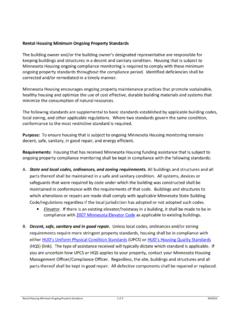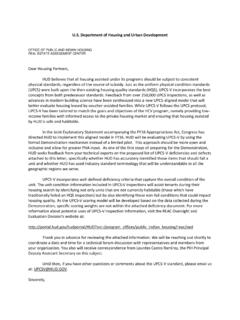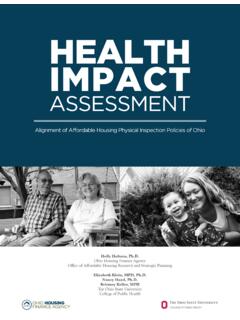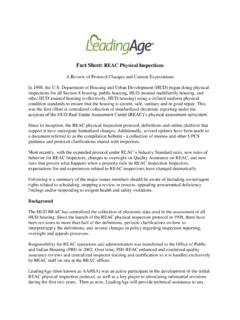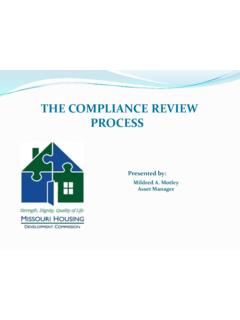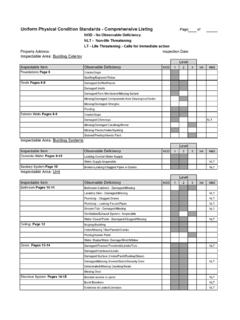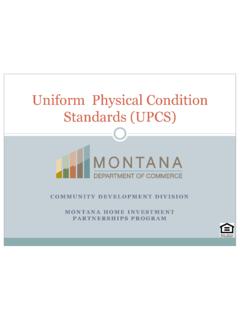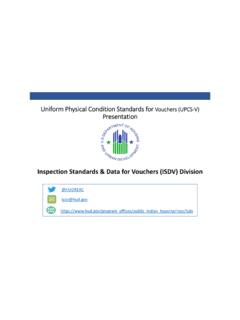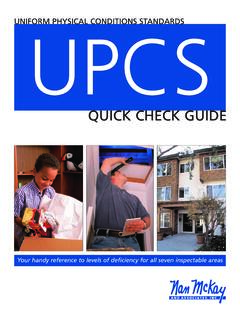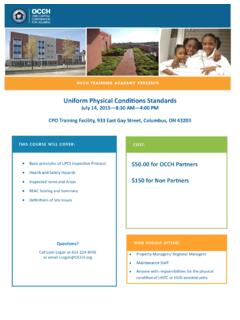Transcription of STANDARDS AND SPECIFICATIONS - sbcountyadvantage.com
1 MULTI!FAMILY REHABILITATION STANDARDS AND SPECIFICATIONSC ounty of San BernardinoDepartment of Community Development and HousingEQUAL HOUSINGOPPORTUNITYECONOMIC DEVELOPMENT AGENCYT able of Contents I. INTRODUCTION .. 3 II. GENERAL STANDARDS .. 4 A. Quality Control and Adherence to Building Codes .. 4 B. Accessibility Requirements .. 5 C. Historic Preservation .. 5 D. Life Expectancy of Systems .. 5 E. Hazardous Materials .. 5 III. SITE conditions .. 7 A. Positive Drainage .. 7 B. Pedestrian Traffic .. 7 C. Holes or Depressions .. 7 D. Exterior Accessory Structures .. 7 E. Trees, Plants, and Grassy Areas .. 7 F. Clutter, Debris, Garbage and Pests .. 8 IV. USE AND SPACE .. 8 A. Use .. 8 B. Space ..10 V. BASIC EQUIPMENT ..10 A. Hot Water Supply ..10 B. Smoke Detectors ..10 C. Carbon Monoxide Detectors ..11 VI.
2 BUILDING STRUCTURE ..11 A. General ..11 B. Exterior ..11 C. Interior ..14 Org April, 2013 - Rev May, 2014 1 D. Windows and Doors ..15 E. Cabinets and Countertops ..16 VII. ELECTRICAL ..17 A. General ..17 B. Outlets ..17 C. Lighting ..17 VIII. PLUMBING ..18 A. General ..18 B. Kitchens ..18 C. Bathrooms ..19 D. Potable Water ..19 IX. HVAC ..19 A. General ..19 B. Heating ..19 C. Ventilation ..20 D. Wood Stoves, Wood Furnaces, and Pellet Stoves ..21 E. Combustion Air ..21 X. ENERGY CONSERVATION ..21 A. Insulation ..21 XI. SINGLE ROOM OCCUPANY (SRO) AND GROUP HOUSING ..21 Org April, 2013 - Rev May, 2014 2 MINIMUM MULTI-FAMILY HOUSING REHABILITATION STANDARDS I. INTRODUCTION The purpose of the Minimum Rehabilitation Standard is to ensure that all persons living in units rehabilitated through programs administered by San Bernardino County (County), enjoy housing that is safe, livable, healthy, more energy efficient, and physically sound.
3 It has been developed to meet the Department of Housing and Urban Development (HUD) requirement that all properties receiving HOME Investment Partnership Program (HOME) and/or Neighborhood Stabilization Program (NSP) program funding meet a minimum standard. The standard includes requirements generic to all such projects and is intended to help identify needed building improvements and to serve as the Minimum Rehabilitation Standard. Multi-family Rehabilitation Housing Program applicants must demonstrate their ability to satisfy this minimum standard within their proposed project s budget. All properties assisted with HOME and/or NSP funds provided through the County s Multi-family Rehabilitation Housing Program, except those required to achieve a different agreed upon standard, must meet and be maintained to these Minimum Rehabilitation STANDARDS .
4 This local Minimum Rehabilitation Standard has been developed in accordance with HOME and NSP regulations, HUD Minimum Property STANDARDS , HUD Section 8 Housing Quality STANDARDS (HQS) and the current edition of the International Building Code (IBC), as adopted by San Bernardino County and/or local code, incorporated by reference and made a part of this standard. Where there is a conflict, the most stringent standard will apply. At development completion, the project applicant must demonstrate that the property complies with applicable state and local codes, rehabilitation STANDARDS , ordinances, HQS, Zoning ordinances, and Lead-Based Paint (LBP) STANDARDS under 24 CFR Part 35 (b). Property inspections are required through the effective affordability period as required by regulations to ensure the property maintains continual compliance.
5 County encourages applicants to consult representatives of the local permitting jurisdiction s Building and Planning Department in pre-development meetings to ensure that potential code deficiencies and building permits are identified and included in the budget. For renovation and rehabilitation developments, some model codes allow for pre-existing deficiencies to remain in place. County staff relies on the opinion of the local planning/building department to determine which deficiencies may remain or must be corrected. However, upon review of the property, County staff reserves the right to selectively mandate correction of certain deficiencies that may be otherwise acceptable to the local building official. A capital needs assessment is required for all multifamily rental projects of 26 or more total units.
6 The final HOME and/or NSP disbursement will be withheld until all deficiencies cited for correction are complete, LBP hazards are corrected and certified and when required, the local building inspector has issued an occupancy certificate. Org April, 2013 - Rev May, 2014 3 II. GENERAL STANDARDS A. Quality Control and Adherence to Building Codes 1. Unless otherwise noted, the STANDARDS outlined in this document will apply to all work done during the course of a rehabilitation project. All Applicants proposing to conduct rehabilitation work must demonstrate their ability to satisfy the Minimum Rehabilitation STANDARDS . 2. The following building codes as adopted by the County will be utilized during the rehabilitation process: a. The current uniform Building Code as published by the International Conference of Building Officials b.
7 The current uniform Mechanical Code as published by the International Conference of Building Officials c. The current uniform Plumbing Code as published by the International Conference of Building Officials d. The current National Electrical Code as published by the National Fire Protection Association e. The current State Title Energy STANDARDS f. The current California Green STANDARDS Code 3. The general standard for this program is the use of at least medium grade materials and quality workmanship. a. Materials and workmanship must conform to the grades and STANDARDS established in this document. b. The San Bernardino County Housing staff must be satisfied with the finished product in order for disbursements to be made. 4. Generally, only new materials will be used in this program.
8 Most used or recycled materials are unacceptable. a. Use of specific recycled materials as mandated by State/local Code requirements is acceptable providing they meet all requirements of this standard. b. Any used material must be tested and found to be lead free or not coated with varnish or paint containing > mg/cm2 lead. c. Used or recycled materials will be medium grade, in like new condition, and consistent with other building finishes. 5. Alternative materials or methods from this standard must be approved by County staff before work commences. Deviations to these STANDARDS may be approved, when deemed appropriate by County staff, depending on funding type, promotional savings on materials, and applicant need. Alternative materials must be submitted to County staff for approval prior to use and must meet or exceed the quality specified in this standard.
9 6. Building permits must be obtained for all permitable activities. All code-related work must pass final inspection by County or local permitting jurisdiction s Building and Planning Department. 7. The applicant bears the ultimate responsibility for all work done by the contractors and subcontractors. If County staff determines that the completed work is below standard (either in materials or workmanship), the applicant, at their own expense, may be required to tear that work out and replace it. Org April, 2013 - Rev May, 2014 4 B. Accessibility Requirements 1. New construction and substantial rehabilitation of multi-family buildings is subject to Section 504 of the Rehabilitation Act of 1973 and must meet the uniform Federal Accessibility STANDARDS (UFAS). In compliance with Section 504 of the Rehabilitation Act of 1973 (29 Section 794, et seq.)
10 , a minimum of three (3) units shall be constructed to be fully accessible to households with a mobility impaired member and an additional one (1) unit shall be fully accessible to hearing and/or visually impaired persons. This project standard is based on the 5% of overall units that must be accessible to the mobility impaired and 2% of the units to be accessible to the hearing impaired. A sampling of UFAS requirements includes: a. An accessible route to all common areas and into and through the unit b. Light switches, electrical outlets, and environmental controls mounted in a range from 15 to 48 inches above the floor c. Bathroom wall blocking for grab bars, and d. Non-grasp handles on doors and sinks 2. Rehabilitation may also need to meet requirements of ICC/ANSI A (Accessible and Useable Buildings and Facilities) as adopted by the County of San Bernardino or local permitting jurisdiction s Building and Planning Department.
